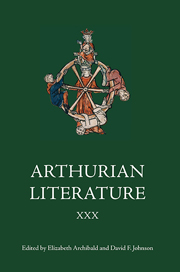Book contents
- Frontmatter
- Contents
- General Editors' Foreword
- List of Contributors
- I Magic and the Supernatural in Early Welsh Arthurian Narrative: Culhwch ac Olwen and Breuddwyd Rhonabwy
- II How Green was the Green Knight? Forest Ecology at Hautdesert
- III Edward III's Arthurian Enthusiasms Revisited: Perceforest in the Context of Philippa of Hainault and the Round Table Feast of 1344
- IV Pagan Gods and the Coming of Christianity in Perceforest
- V Malory's Sources for the Tale of the Sankgreal: Some Overlooked Evidence from the Irish Lorgaireacht an tSoidigh Naomhtha
- VI ‘Transmuer de rime en prose’: The Transformation of Chrétien de Troyes's Joie de la Cour episode in the Burgundian Prose Erec (1450–60)
- VII La Rétro-écriture ou l'écriture de la nostalgie dans le roman arthurien tardif: Ysaïe le Triste, Le Conte du Papegau et Mélyador de Froissart
- VIII Remembering Brutus: Aaron Thompson's British History of 1718
- Contents of Previous Volumes
II - How Green was the Green Knight? Forest Ecology at Hautdesert
Published online by Cambridge University Press: 05 March 2014
- Frontmatter
- Contents
- General Editors' Foreword
- List of Contributors
- I Magic and the Supernatural in Early Welsh Arthurian Narrative: Culhwch ac Olwen and Breuddwyd Rhonabwy
- II How Green was the Green Knight? Forest Ecology at Hautdesert
- III Edward III's Arthurian Enthusiasms Revisited: Perceforest in the Context of Philippa of Hainault and the Round Table Feast of 1344
- IV Pagan Gods and the Coming of Christianity in Perceforest
- V Malory's Sources for the Tale of the Sankgreal: Some Overlooked Evidence from the Irish Lorgaireacht an tSoidigh Naomhtha
- VI ‘Transmuer de rime en prose’: The Transformation of Chrétien de Troyes's Joie de la Cour episode in the Burgundian Prose Erec (1450–60)
- VII La Rétro-écriture ou l'écriture de la nostalgie dans le roman arthurien tardif: Ysaïe le Triste, Le Conte du Papegau et Mélyador de Froissart
- VIII Remembering Brutus: Aaron Thompson's British History of 1718
- Contents of Previous Volumes
Summary
One of the abiding impressions made by Sir Gawain and the Green Knight (henceforth SGGK) on its readers is that the Green Knight is an embodiment of nature. An earlier generation of scholars saw the poem chiefly as a museum of Celtic folklore, but Celtic paganism and the ‘Green Man’, both associated with a mystical, proto-Romantic reverence for the natural environment, remain a part of its critical heritage. Despite the manifest courtliness and hospitality practised at the Green Knight's castle, where Gawain spends Christmas week before riding to the Green Chapel on New Year's Day, the view persists that the Green Knight presides over a world that is very much ‘natural’ or ‘wild’ in contrast to Gawain's and Arthur's. This is perhaps because both in the form of Bertilak and in the form of the Green Knight, Gawain's host and adversary are represented as a man of the forest. As Bertilak (whose name is revealed to Gawain in 2445), he leads boisterous hunting parties three days in a row, traversing the forest around his castle. As the Green Knight, he maintains the seemingly remote Green Chapel in a rugged landscape that impresses Gawain as ‘wylde’ (2163), the oratory of the devil himself (2190–4), even though it stands somewhere within or very near to the forest where Bertilak hunts – in fact, it is ‘not two myle henne’ (1078), as Bertilak cheerfully informs Gawain.
- Type
- Chapter
- Information
- Arthurian Literature XXX , pp. 27 - 54Publisher: Boydell & BrewerPrint publication year: 2013

